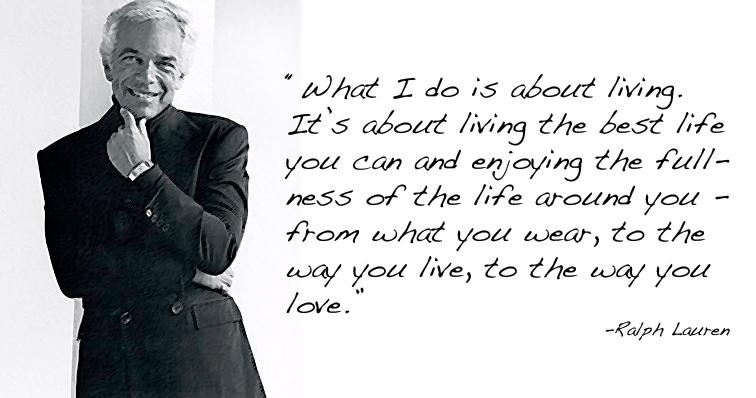The present & future state of the Italian fashion industry: cultural influences, challenges of globalization & transparency, strengths, & opportunities.
Read MoreRalph Lauren: American Classic
All about Polo Ralph Lauren: the man behind the brand, the company history, brand strategy, ethics and challenges.
Ralph Lauren became the single most profound industry-transformer of the past century by maneuvering his product offering, brand extension and marketing to evolve from a neckwear designer into a brand ambassador for an entire lifestyle, thus creating the "Lifestyle Industry". Throughout the past forty years, although the company has experienced financial ups and downs, acclaim and criticism alike, it has remained one of the most successful fashion businesses in the world.
The following is my effort to capture the story of the Polo Ralph Lauren company, moving from the history of the man behind the brand to the structure of the business.
Ralph Lauren: The Man

Ralph Lifschitz was born into a working-class family in the Bronx, New York City in 1939. Coming from a long line of Orthodox Jews, Ralph's late mother is rumored to have wanted her youngest son to become a rabbi. However, young Ralph's father was a house painter, and Ralph himself had ambitions of becoming a millionaire- according to his high school yearbook.
Young Ralph was apparently driven to become the ideal "self-made man" from an early age. Throughout his youth, he worked summers in the Catskills, where he observed the wealthy American lifestyle that would capture his imagination. Later, Ralph worked in New York department stores and spent his savings on expensive clothes, becoming the best dressed of his classmates by the age of 12.
By 16, he and his brother Jerry had both changed their names from Lifschitz to Lauren. The idea of dressing for the position (or lifestyle) you hope to attain has served as a mantra for Ralph Lauren's subsequent success, as he has enabled millions to do just that.
People ask, 'How can a Jewish kid from the Bronx do preppy clothes?' Does it have to do with class or money? It has to do with dreams. -Ralph Lauren
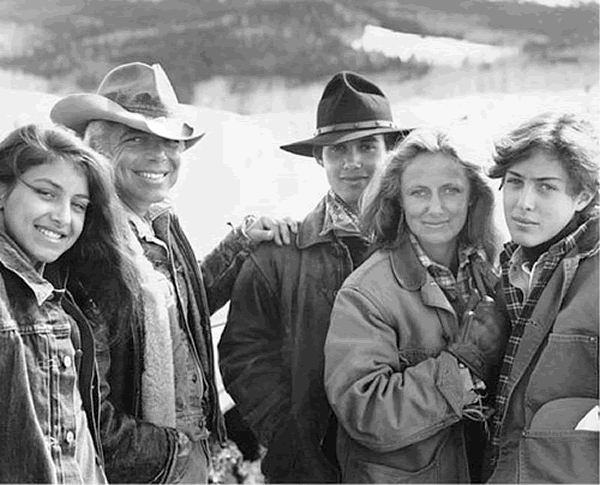
After serving in the US Army for two years (1962-64), Lauren was discharged and quickly married Ricky Lauren. They have three children together.
While selling ties at Brooks Brothers, Lauren attended night school in business at City College in NYC. While working in the "preppy" world of Brooks Brothers and observing other like-minded companies, Lauren realized there was a largely unserved market for people like himself, who wanted to dress within a certain "blue-blood" lifestyle, without appearing stuffy or breaking the bank. He began to tap into this market by veering away from the popular "skinny tie" to create wide, colorful neckwear.
A tie was the way a man expressed himself. I believed that men were ready for something new and different. They didn't want to look as if they worked for IBM. A beautiful tie was an expression of quality, taste, style. -Ralph Lauren
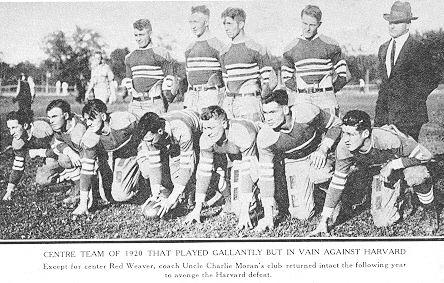
Ralph Lauren took inspiration from the yearbooks of Princeton, Harvard and Yale, and from old photographs of prominent Americans, as well as his own personal idea of the images that represent the classic American heritage and the "sporting gentleman." He went on to develop the largest lifestyle company in the world.
In 1987, after the removal of a benign brain tumor, Lauren began a longterm commitment to philanthropy. The Polo Ralph Lauren Foundation was created for the purpose of providing support for philanthropic programs including education, healthcare in medically under-served communities, the arts and community-based initiatives. His family and company have supported historic preservation activities and numerous cancer research initiatives, including the Pink Pony campaign for breast cancer. In addition, Lauren founded the Ralph Lauren Center for Cancer Care and Prevention in 2001.
Lauren's company was floated on the stock market in 1997, and Forbes now lists him as one of the world's billionaires. He and his wife, Ricky, have five homes, each filling in a chapter of Lauren's ideal American existence. There is the apartment in Manhattan and two houses not far away: a beach house in Montauk, at the tip of Long Island, and an estate in Bedford (see Architectural Digest, November 2004), an hour north of New York City. There are also two more distant places: a ranch in Colorado (see Architectural Digest, November 2002) and a two-house retreat in the posh Round Hill resort, near Montego Bay on Jamaica (see Architectural Digest, November 2007).
It seems that Lauren's childhood dreams have been dwarfed by his larger-than-life reality.
The best thing you can do is go away from this saying, 'I can do this too,' because it's all possible, and I'm living proof. -Ralph Lauren
Below is a one-hour interview from 1993 where Ralph Lauren speaks with Charlie Rose about his life, his inspirations, and his business. (You may have to drag the scroll bar to get this ancient video going.)
The History of Polo Ralph Lauren
1939: A Star is Born
Ralph Lifschitz was born in the Bronx, & later changed his name to Lauren.
1960s: Chasing the Dream
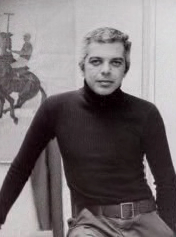
Lauren studied business at City College in Manhattan while working as a glove salesman. He later began working for tie-manufacturer A. Rivetz & Co, who refused to produce his wide-tie design in the era of skinny-ties. Lauren dropped out of school just before graduation, and convinced clothier Beau Brummel to manufacture his Polo line of neckwear. Within a year, Lauren took out a $50,000 private loan from clothier Norman Hilton and founded the Polo Fashions, Inc. business with his brother, Jerry (the name would become the Polo/Ralph Lauren Corporation -PRL- in 1987).
The ties were first sold in small menswear shops and later in fashionable department stores. Bloomingdales originally refused to sell the ties unless Lauren agreed to remove his label in order to reduce the tie-width. Lauren refused, and Bloomingdales had only to look at the success of his sales figures to understand that they were mistaken. Lauren's colorful wide ties found a niche - even at Bloomies, and the brand was expanded to include men's business attire and sportswear. The company designed, manufactured and distributed the entire Polo collection.
From the beginning, Lauren established clear stylistic codes that embraced the myth of the American aristocracy by merging classic American style with the refinement, tailoring and sensibility of European fashion.
1970s: Branded Genius
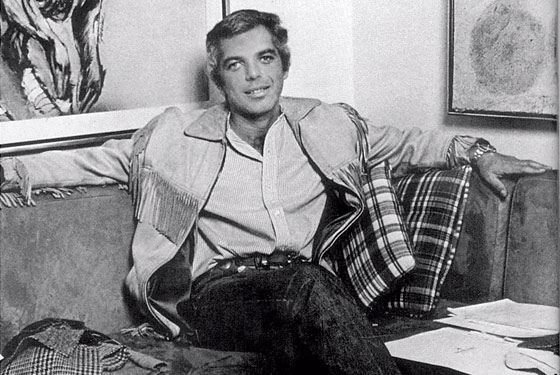
Lauren won the Coty Award for menswear, and immediately produced a line of men's dress shirts cut for women, in addition to the now infamous Polo shirt with the breast logo. Both lines were a huge success, but by 1972 the company was almost bankrupt. The young entrepreneur had proven himself a genius at establishing a strong brand identity with lightning-speed, but had difficulty managing the finances and logistics of a fashion business.
Lauren invested $100,000 of his own savings into the company and recruited Peter Strom from his post at Norman Hilton to become his business partner. Lauren then owned 90% of the company, while Strom owned 10%.
Strom and Lauren proved themselves a dynamic working team. As Strom reported to the New York Times:
We divide the work this way: I do everything Ralph doesn't want to do; and I don't do anything he likes to do. He designs, he does advertising, public relations; I do the rest.
In this spirit of doing what you like and what you're good at (not bad advice, by the way), Strom and the Lauren brothers scrutinized their business structure and adapted it to what they did best: design and marketing. Manufacturing of the women's line was licensed out to experienced producer Stuart Kreisler, who was enthusiastic about building the Lauren brand.
Under the licensing agreement, Lauren would design, and Stuart Kreisler would manufacture and distribute the line while sharing advertising costs, with Lauren earning 5-8% of the wholesale revenues. The structure of this agreement would serve as the model for future PRL licensing efforts.
In addition to this agreement, Strom insisted that all retailers carrying Polo products would be required to sell the entire line, including the most expensive suit (which cost $350). While this initially eliminated 2/3 of the retailers carrying Polo, the retailers who remained developed a loyal working relationship with Lauren.
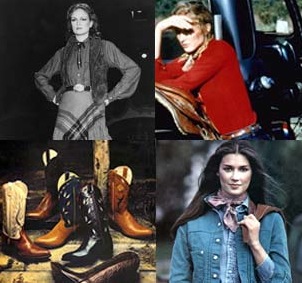
By the end of the decade, Lauren had moved the company from the brink of failure into an emerging powerhouse. He also created a smash-hit Westernwear collection in addition to fragrances for men and women. He designed the wardrobes for The Great Gatsby (1973) and Annie Hall (1978), influencing the way millions dressed -although without the product placement that would bring Armani fame in American Gigalo in the 80s. He had also won the American Fashion Award, and was elected into the Coty Hall of Fame for both menswear and womenswear.
With the company finances back in order, Lauren returned to building his brand image and began to invest in extensive advertising spreads that used powerful imagery to tell the story of the Polo Ralph Lauren lifestyle. A movement that went beyond clothing was born.
1980s: Building the Lifestyle Empire

Lauren continued his brand expansion to include childrenswear, eyewear, underwear, jeanswear, shoes, accessories, housewares, furs, luggage, and a range of other products. However, unlike most companies who suffered brand image dilution from rapid expansion using licensees, the image of Polo was only strengthened. There were several reasons for this anomaly, but the main ones were that Lauren designed everything himself or held final design approval, and retail imaging was carefully controlled by the brand through franchises or shop-in-shops.
Only two product categories gave the brand substantial problems: fragrances and the home collection. The fragrance sales were lacking until Lauren found the right licensing partner in Cosmair, Inc. who was willing to help develop and promote the products. Sales in Polo, Polo Sport, Lauren and Safari fragrances skyrocketed.

The home collection, on the other hand, received widespread praise for brilliant comprehensive design, but suffered at the hands of the licensee. It was originally licensed for production and distribution to the J.P. Stevens Company, who had difficulties getting the products to retailers on time and demonstrated poor quality control. In addition, they required that retailers construct specific free-standing boutiques within their stores to display the items- at a cost of $250,000 each! Retailers obviously balked at this figure. The result: low-quality home goods and expensive requirements for stores = unhappy customers and retail partners. It took the company years to recover the home collection.

Nevertheless, all Polo products embraced an idealized aspect of the American cultural experience, and this concept was reflected in the store design and advertising. The Santa-Fe collection was added to the brand in 1981, providing Navajo-inspired designs that were a global success. To produce the ultimate in-store brand experience, the company went through an elaborate process of historic restoration to create the first flagship store in the 1890s Rhinelander mansion on Madison Avenue, opened in 1986. This would be followed by the development of a London flagship on Bond Street and the brand's largest international store in Paris.
The company now has stores in more than 31 countries, and controls more than 50 brand outlets at a significant distance from regular retailers to prevent inter-brand competition while controlling the brand image.
1990s: New Frontiers

Difficulties did not allude the brand. The recession of the early 90s saw cutbacks in Polo's retail operations. According to retailers and various news sources, many manufacturers had begun copying Lauren's designs and selling them at lower prices.

However, PRL continued to roll in the cash with the introduction of the Polo Sport and Double RL Jeans lines, and Lauren received the CFDA Lifetime Achievement Award in addition to awards for best menswear, womenswear and retailer.
The company's continued success positioned them for the profitable sale of 28% of the company to a Goldman Sachs & Co. investment fund for $135 million in 1994. The company then went public in 1997 on the NYSE when Lauren sold 18 million of his personal shares for $465.4 million. He still retained 90% of company voting rights, enabling himself to maintain control over the direction of the brand.
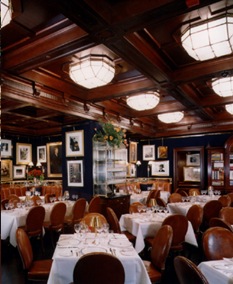
Throughout the 90s, the company continued with brand expansion projects, and shifted several of its licensing agreements in an effort to provide high-quality products at several price points, thus embracing the full lifestyle offering. By the end of the 1990s, nearly 300 licensing agreements were in place. Of the brand's 200+ retail outlets, about half were operated through licenses, and yet the brand image remained intact.
As the new century approached, the company continued to grow while maintaining a strong image rooted in the idealized dream of American culture. Ralph Lauren further diversified the brand through the development of the Purple Label (tailored menswear) in 94 and the opening of the RL restaurant in Chicago in 99. He also began to demonstrate the philanthropic nature of the company before it became fashionable, spearheading efforts in historic preservation in the States and the fight against cancer.
In the late 90s, the company acquired Club Monaco to get a handle on the younger market which competitor Tommy Hilfiger had captured, yet had remained allusive to Ralph Lauren. The RALPH line was then created to target the "daughter of the Lauren market".
2000s: Media Master

Ralph Lauren had grown from a tie-designer into a lifestyle mogul in just 30 years, creating the industry path to success that others would scramble to follow. However, the company's spirit of innovation didn't stop with the 90s.
In 2000 the company formed a multimedia marketing joint venture with NBC and affiliates, and ValueVision (operator of the Home Shopping Network). With the new media capabilities this partnership enabled, the company began to explode with cutting-edge communications strategies that would leave the rest of the industry years behind.
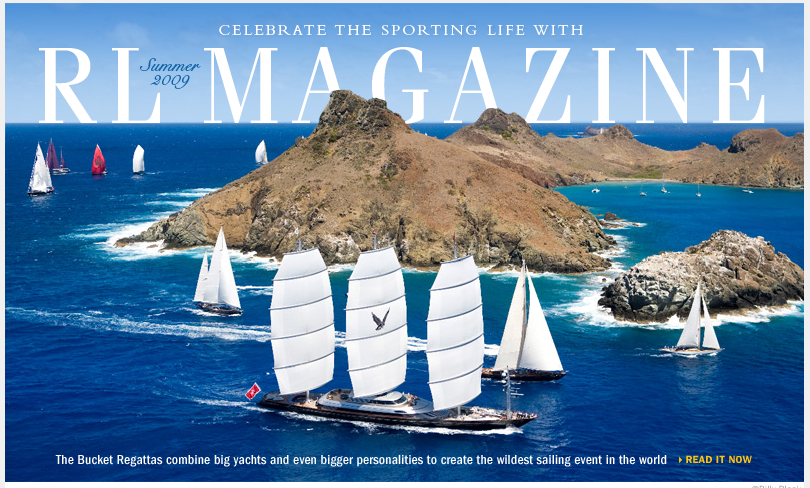
PRL's first television campaigns began immediately. Polo.com was developed in 2000, providing one of the first mono-brand e-commerce sites in fashion history. It was followed in 2001 by the online magazine outlining all things celebrity, sport, art and culture that would appeal to the ideal American persona that Lauren had built. That same year, Runway.Polo.com was launched, providing fashion fans with a look behind the scenes in collection-development and fashion shows, while offering style and beauty tips. Just one year later, the Home site was launched, exploring every item in the collection and offering decorating tips to readers.
By 2003 the International Website had launched, providing a glimpse into the Ralph Lauren lifestyle for the first time for many new markets around the world. The Create-Your-Own project also debuted online, enabling users to interactively "design" their own Polo shirts by selecting from available color combinations and graphics. The venture proved very successful and was repeated in subsequent years.

The technological integration continued with the creation of the Virtual Window Shop, a touch-screen monitor on the window of the Madison Avenue store that allowed customers to shop "online" anytime, even after the store's closing hours. More than increasing the number of virtual shoppers at the store site, the window really served to generate hype and publicity for the brand. The window piece was featured in most fashion publications worldwide, in addition to business news and technology publications. The window, in effect, became a tourist destination.
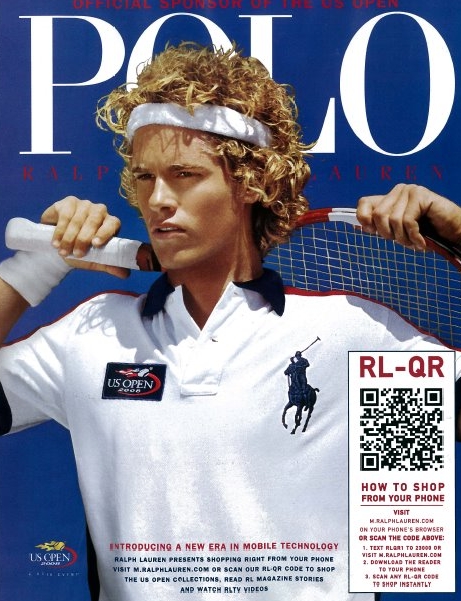
In 2008, consumers with SmartPhones were enabled to shop from the pages of their favorite magazines by scanning Quick Response (QR) codes in PRL ads with their mobile phones. Several iPhone applications were also launched to attract brand fans to interact from anywhere they could get a signal.
In the never-ending brand battle to win the hearts of the next generation, PRL launched the Rugby line in 2004 (yes, that's before Gossip Girl) in an effort to attract the "burgeoning college" market. The Rugby line provides aspirational lifestyle products in a preppy, youthful style through a vertical retail format (meaning the PRL controls logisitics, distribution and retail). Rugby.com was worked over in 2008 to provide e-commerce, mobile commerce, media content, and the make-your-own features that had proven so popular with Polo.
By 2007, its 40th year in business, Polo Ralph Lauren was a $4.3 billion enterprise with a presence in 80 countries. Offerings at nearly every price point — from value to luxury — covered men’s and women’s apparel, home goods including paint, accessories, fragrances and eyewear at the time of the brand's anniversary celebration and commemorative book release.
Lauren himself has been awarded the CFDA’s American Fashion Legend Award and the first-ever Voter's Choice Award, and continues to lead and support numerous philanthropic endeavors.
PRL remains a flexible business model, integrating retail, wholesale and licensing to most effectively provide the world of Ralph Lauren to consumers. The company's brand names include, among others: Ralph Lauren, Polo by Ralph Lauren, Ralph Lauren Purple Label, Black Label, Blue Label, Lauren by Ralph Lauren, Polo Jeans Co., RRL, RLX, Rugby, Ralph Lauren Childrenswear, Ralph Lauren Baby, Ralph Lauren Home, Lauren by Ralph Lauren Home, American Living, Chaps, and Club Monaco.
In spite of 4th quarter losses at the end of Fiscal Year 2009 (which closed on March 28, 2009), net revenues for the year grew 3% to $5.02 billion from $4.88 billion in the previous year. These gains are attributed to increased wholesale and retail sales, but have been diminished by the loss of some licensing fees as PRL has bought back licensing rights in key markets to strengthen the brand image abroad. The company continues to focus on longterm growth, enhancing development abroad — especially in SE Asia — and pushing the pattern of innovation in products and operations in the coming years.
The current economic crisis ensures that Fiscal 2010 will be challenging for PRL, but the company strategy of brand protection (bound by brand building and extension, specialty retail including web, and international expansion) has most speculators confident that the company will continue to thrive.
Ralph Lauren: The Brand
All lines of PRL represent the idea of the American Aristocrat, rich in European heritage with a mix of New England urbanity and a rugged country flair.
The look embraces a style that is sporty, preppy, wealthy, traveled, and timeless while remaining modern.
Within this ideal, each line represents its own niche, although there has reportedly been some confusion among customers as to what each line stands for (perceived brand overlap). This is understandable, given the number of lines the company has produced. Below I have placed some of them into positioning maps by style and price-point (there are many lines missing from this map, some available only in specific markets- like Lauren for Men, others discontinued or owned by the company but not in use). Obviously, all styles from elegant to athletic fall within the broader "classic" category.
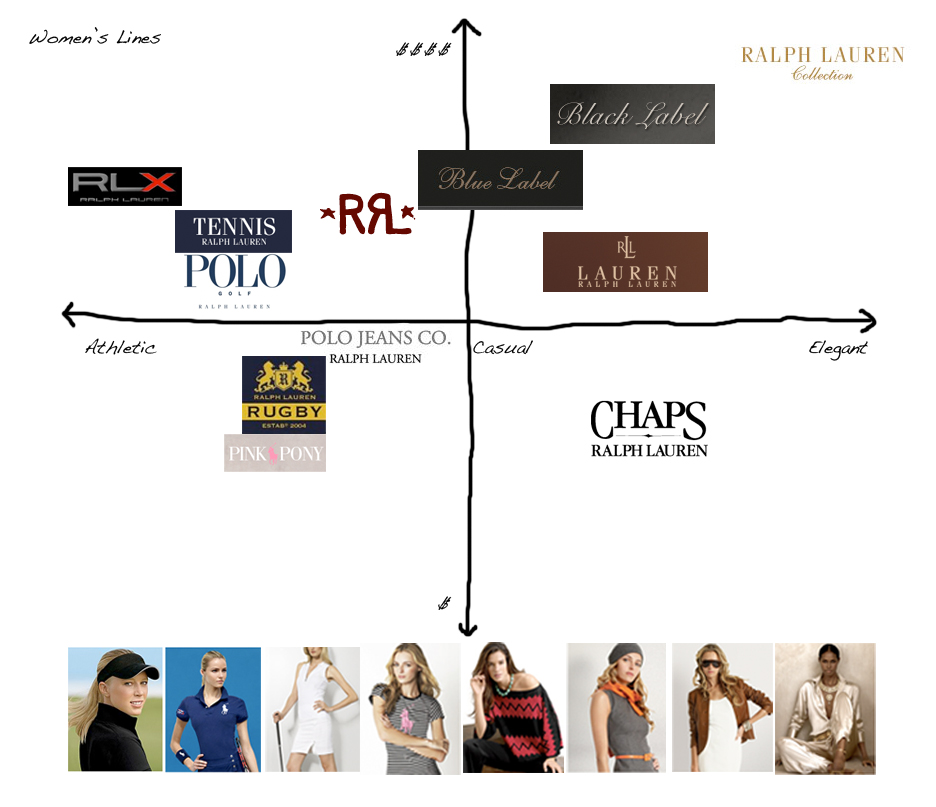
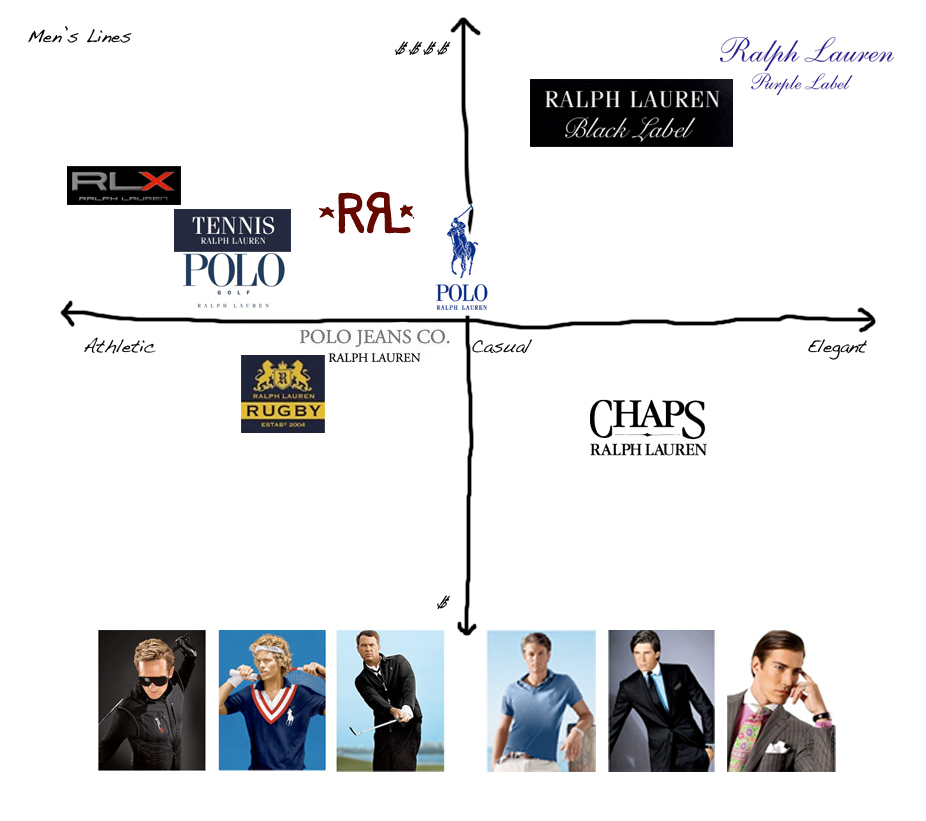
PRL Communications & Marketing
In the early years, Polo Fashions was marketed solely through the efforts of the department stores that carried the brand's products. The advertisements included store window features and newspaper ads.
In addition, Ralph Lauren was one of the first designers to have his own shop-in-shop within individual department stores. Through the techniques of set design, he created a specifically branded environment to house his products while reflecting the attitude of the Ralph Lauren lifestyle.

Film would serve as Ralph Lauren's inspiration in his collections and in his future marketing efforts. Many have complained that he is not a "true" designer, taking images from films and other sources and designing collections around them. But what creative has not done this?
In 1974 the name Ralph Lauren wascatapulted into the fashion industry forefront after the release of The Great Gatsby, a monumental film in which Lauren designed the wealthy characters' wardrobes.

Just three years later, Lauren would again work with a film to create the looks for Annie and Alvy, the main characters of Woody Allen's infamous Annie Hall. With this film, Allen created a classic film school staple in ironic comedy, and Lauren created a style icon in Diane Keaton.
In the mid-1970s, PRL dedicated about $400,000 per year to marketing efforts. Once or twice a year, the company produced 20-page spreads to be released to several major magazines, instead of the standard one- or two-page ads most other brands released monthly. The spreads looked like movie stills, capturing the lives of characters within a film based on upper-class Americana.
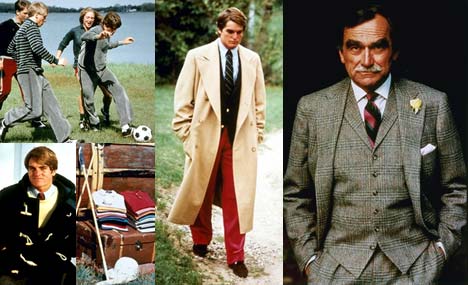
Lauren explained the marketing strategy:
When we appear, we’ll be a star. It’s like Frank Sinatra. If you see him once a year on TV, it’s an event. If you see him every week, it’s no big deal.

Over the years, as PRL released more lines targeting different age groups of men and women within the brand's style, the ads were adapted, always maintaining a cinematic style. All advertising images continue to represent a chapter of the American story, from an elite perspective.
Lauren himself had come to personify the lifestyle he was selling, and appeared in many ad campaigns and in various magazines with his family.

In addition to traditional media advertising, PRL had continued to focus on the physical environment of each store, having grown from shop-in-shops in the 70s to hundreds of flagships and freestanding stores worldwide. Each store is designed for the specific environment, from New York to Milan to Palm Beach. While decorative features my be unique for each site, all embrace a classic upper-class American lifestyle image.
After PRL's media partnership with NBC was established in 2000, TV spots were added to the communications strategy, finally demonstrating the brand in actual film shorts for apparel, home and fragrances.

The media partnership also provided the capabilities PRL needed to develop a branded website that could capture the Ralph Lauren sensibility, lifestyle, and clothing. Directed by Lauren's son, David, the website contains products and media content, intended to bring the brand to life in the virtual realm. Lauren has described this combination of merchandising and entertainment as "Merchantainment." Added to this feature is Ralph Lauren RL TV, which includes behind-the-scenes footage of fashion shows and photo shoots, Lauren-esque celebrity and athlete interviews, and any additional content that might appeal to the ideal Ralph Lauren lifestyle-consumer.
In 2008, applications were released to integrate these functions on the iPhone and other smartphone devices.
Examples of PRL's cinematic commercial spots are everywhere on YouTube. Here is just a handful:
The Polo Ralph Lauren Business

Now a publicly-traded company, the Polo Ralph Lauren business model is built around six primary objectives designed to keep the brand strong while bringing in the big bucks:
- Creating unique businesses primarily centered around one core and heritage-driven brand;
- The ability of PRL to maintain a singular "American Aristocrat" image has provided unity across the brand in all product categories, and has enabled the company to take a leadership role in this now-saturated market. (If you create the market, you basically own it until someone else does it better, and so far nobody has done it better than RL.)
- Diversifying and expanding products and prices, distribution channels and geographic regions;
- PRL is creating something for everyone in most price ranges to ensure that anyone who WANTS to own a piece of this imagined American lifestyle can.
- Improving brand control and positioning;
- When the company has direct control over distribution and quality control, they can ensure that the brand represents the same image everywhere. This is important in an era when customers travel the world and have access to infinite information online. If the brand is poorly represented in one market, a customer seeing this is less likely to think the brand's product is worth a high price in a more successful market.
- Focusing on selective strategic partnerships;
- The company needs the best partners to represent their image properly, produce products and deliver them with expertise, and reduce costs in line with company goals. When PRL selected a poor licensing partner for their Home Collection, a lot of damage was done to the brand through low quality products, delayed delivery, and high costs.
- Implementing infrastructure improvements that support a worldwide business;
- This doesn't just mean building the best "American-style" stores in key markets, but creating a logistics system that enables the company to do efficient business around the world and training employees everywhere to represent the image of Ralph Lauren in the same way throughout various cultures.
- Funding expansion through strong operating cash flow.
- This enables the company to use its own money from sales and royalties to fund activities that would otherwise require great external debt. Not only is this good financial management, but it gives the company the freedom to invest in critical initiatives without having to depend on an external party.
Currently, PRL is focused on growing the brand internationally, opening stores in new markets and strengthening the perceived brand image in key areas.
Additional plans outlined in the annual report include further brand extension and product diversification (expanding the Lauren line in Europe, and growing the offering of accessories), increasing direct-to-consumer marketing in key markets (including TV, print, online, etc. and focusing first on Paris), and cost-saving strategies (reducing operational costs and profit margins to provide a lower price range to customers).
International Expansion of PRL
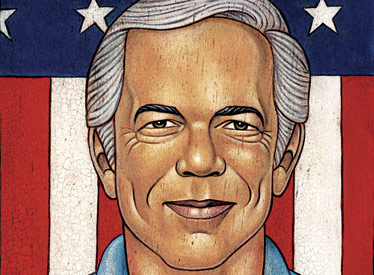
While proving a lifestyle powerhouse in the States, Ralph Lauren wanted to continue his market expansion overseas. Like many consumer goods companies, the method of expansion used by PRL was essentially: find quality manufacturers and distributors in key markets, and form licensing agreements with them. This practice would give the company a foot in the door of foreign markets, using local experts. When opportunity struck, PRL would buy back the licenses or acquire the licensee companies to bring control in-house.
As part of our growth strategy, we seek to extend our brands, expand our geographic coverage and increase direct management of our brands by opening more of our own stores, strategically acquiring or integrating select licenses previously held by our licensees and enhancing our operations. -2009 PRL Annual Report
Beginning in 1998, PRL began buying back many of its European licensing rights while continuing to open flagship stores (London, Paris and Milan) in addition to outlets in France, the UK and Austria. In 2005, PRL's business in Europe counted for 15.7% of worldwide wholesale net sales (up 150% from 2000). At that time, the company announced its goal to move the European market from a $700 million business to a business worth $1 billion by 2010. This goal was achieved in March 2009 when the net revenue for Europe totaled more than 20% of worldwide sales at just over $1 billion.
PRL worked hard to achieve this goal of growth in Europe, not only by building flagship stores in key cities, but also by increasing their focus in wholesale (selling through external retailers including key boutiques and department stores). Today, about 2,100 stores carry PRL lines through wholesale in the US, compared with about 3,900 stores in Europe. -Much of this difference is due to the fact that, in Europe, there are many different department store chains and other retail avenues that are unique among individual countries.
While PRL owns many branded stores in the US, in Europe the business is still supported greatly by third parties who are trusted within the local markets. This has the effect of giving the PRL lines a foot in the door, but it also adds a new level of complication as the company must deal with many different distributors while maintaining the same global image.
According to the company's annual report, PRL's latest goal is to repeat this growth strategy in Southeast Asia, which is comprised of China, Hong Kong, Indonesia, Malaysia, the Philippines, Singapore, Taiwan and Thailand (bringing the Asia-Pacific market to 1/3 total company revenues). Sales in Japan alone have increased by more than 500% since 2007 (to $393 million), and PRL anticipates even greater results in China. The company plans to transition their retail and wholesale operations in Southeast Asia from licensees to internal ownership by 2010, and will continue to integrate the businesses they have already acquired in Japan into the PRL infrastructure.
Philanthropy, Ethics & Sustainability at Polo Ralph Lauren

Polo Ralph Lauren has made strategic investments in support of particular "WASP" sporting events, naturally including polo. In addition, the company has served as the official outfitter not only for the Wimbledon but also for the US Olympic and Paralympic teams. Beyond athletics, the Lauren family has made philanthropy a part of the company's mission for 20 years.
Ralph Lauren has been an active philanthropist since the mid-80s, when he had a benign brain tumor removed. Afterwards, he became an important leader for the fight against cancer (from fundraising to founding or funding research and treatment initiatives and a clinic), but he has also participated in AIDS charities such as God's Love We Deliver.
Philanthropic efforts also surround a theme that is close to the culture of the brand: historic restoration of American icons. Whether in the rich environment of his adopted homestead in Bedford, NY or in the winter getaway island of Jamaica, Ralph Lauren has created and funded numerous restoration projects that serve to maintain historical landmarks near to the hearts of Americans.
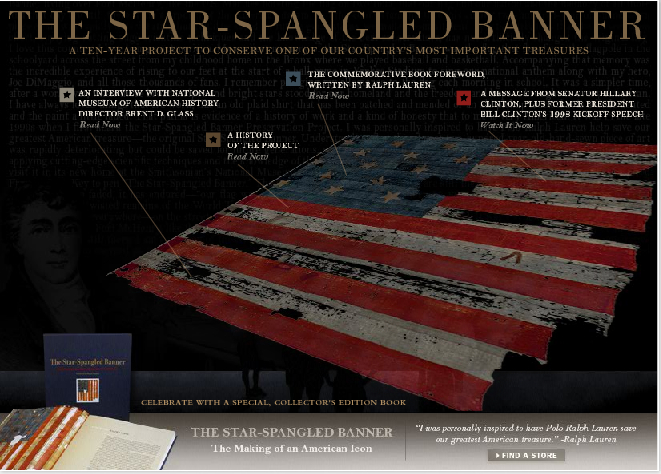
Beyond architectural restoration, a team funded by Lauren has recently completed restoration efforts of the original American flag, which inspired the writing of the US national anthem. The flag is now housed within the Smithsonian Museum in DC.
In addition to charities based on Ralph Lauren's personal interests, or the interests close to the image of the brand, PRL has recently (and quietly) explored a new chapter of activity, focusing on ethical production in response to accusations of abuse.
A Note on Ethics

In early 1999, a highly-publicized lawsuit was filed in the California courts on behalf of sweatshop workers in the Northern Marianas Islands against 18 US retailers and manufacturers, accusing them of violating RICO racketeering statutes that specifically prohibit peonage and involuntary servitude, and allow suits against anyone benefiting from such an enterprise. Among those accused were retailers Nordstrom's and J.C. Penney, as well as PRL competitors J Crew and Tommy Hilfiger.
As a protective measure, PRL agreed to require and help finance independent monitoring of its own and other factories in the Islands. The company also agreed to settle a class-action lawsuit over substandard working conditions in factories on the Pacific island of Saipan, where another series of lawsuits had originated regarding substandard working conditions.
In the case of the Saipan lawsuit, defendants included PRL competitors Calvin Klein Inc. and Tommy Hilfiger USA Inc.; retailers The May Department Stores Company and Sears, Roebuck & Company; and major PRL licensee Warnaco, Inc.
Since settling the Saipan lawsuit, PRL has received low but improving marks from labor watchdogs around the world. While they have been supportive of factoring monitoring and send staff to monitor factory working conditions, they have found difficulty in obtaining a squeaky-clean reputation. Along with the other companies who must operate through licensees and third-party contractors, it is difficult to know exactly what is going on with producers at all times - this is why brands such as PRL often buy back their licensees to regain control over their brand little-by-little.
As PRL has continued to expand over the years, many production efforts have been licensed to companies who manufacture through factories in Southeast Asia and other parts of the world where labor prices are still low enough to meet current company practices set to achieve consumer-approved prices. Through language barriers and bureaucratic roadblocks, it is often difficult to understand just what factories are producing what products. (It is a common practice for less ethical producers to show brand staffers and inspectors only the factories where the highest standards are met, while other factories are kept off the record.)
As PRL moves into the Southeast Asian market, one would hope that they can regain more control over their manufacturing efforts in the region. While PRL has made many cutting-edge advances in marketing and communications, and seems to have an endless supply of ideas for lines that satisfy consumer demand, they will need to pay more attention to the idea of "ethical fashion," which is becoming increasingly important to consumers worldwide.
Sustainability
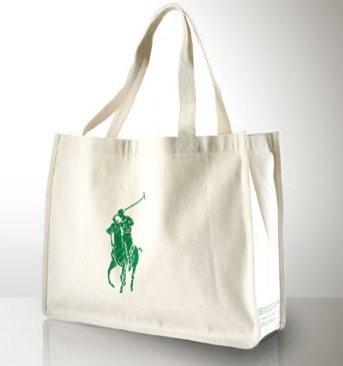
In 2007, PRL retained the services of GreenOrder, a strategy and management consulting firm specialized in sustainable business. They worked with the company to identify PRL's environmental impact throughout the product cycle, to identity and prioritize opportunities for improvement, and to outline steps for achieving new sustainable business goals.
As a result of the process, PRL has developed new shipping practices that cut greenhouse gas emissions. They have also started to focus on green development for new stores and offices, and have implemented internal practices to reduce papaer and energy consumption.
The Founders Dilemma (Solved)
Because most fashion companies are branded around the personality of the designer - from Tom Ford to Yves Saint Laurent - there is often a huge challenge presented when the founding designer retires or, as was the recent case with Gianfranco Ferre, dies. In the past, companies like Dior brought on outrageous celebrity-status designers to bring new energy and media exposure to their brands after the loss of the namesake designer.
More recently, this practice is changing because people care less about a wild designer than a continued aesthetic and symbolic value presented by a brand. However, finding a head designer that can perfectly transition the values of the namesake into a new generation is quite a difficult thing.

This is not the case with PRL. David Lauren, Ralph's oldest son, has been an integral part of his father's business. Today, David is in charge of Polo Ralph Lauren's marketing, advertising and corporate communications and the driving force behind the company's new look (that's Senior Vice President, at only 37 years old). He has brought polo.com to the forefront of digital fashion initiatives, and is highly invested in the success of the company.
David Lauren has unique experience that would make him a great fit (from an outsider's view, anyway) as successor to his father's position. First of all, he has grown up within the Ralph Lauren lifestyle, and from an early age experienced the American rituals that his father only dreamed of as a child. He understands the business as well as anyone could because he grew up with it.
While in college at Duke, David founded a magazine called Swing, which had broad readership among its targeted 20-something market, but folded after 5 years. David then joined his father's company, and was the force behind the Rugby line as well as polo.com. He has shown that he can connect with the younger markets, a mission that often alluded his father.
Since PRL is now a public company, issues of succession are not controlled by Ralph Lauren alone. However, David has proven himself a likely candidate when a time for transition emerges.
Sources
investor.ralphlauren.com, polo.com, wwd.com, fundinguniverse.com, askmen.com, infomat.com, architecturaldigest.com, time.com, nytimes.com, harbus.org
Armani: King of Italian Fashion
Giorgio Armani and the business he developed provide the perfect example of the evolution of the Italian Fashion System from the perspective of the designer. He began as a pure designer, and then gradually acquired various production facilities into his company on his route to becoming a fashion and lifestyle powerhouse.
Read MoreThe Italian System for Fashion
An overview of the four primary cycles in the development of the Italian fashion industry from post-WW2 creation of industrialized production systems, to fashion democratization in the 1980s and the boom of "Made in Italy," to brand concentration and mergers of the 1990s...
Read More